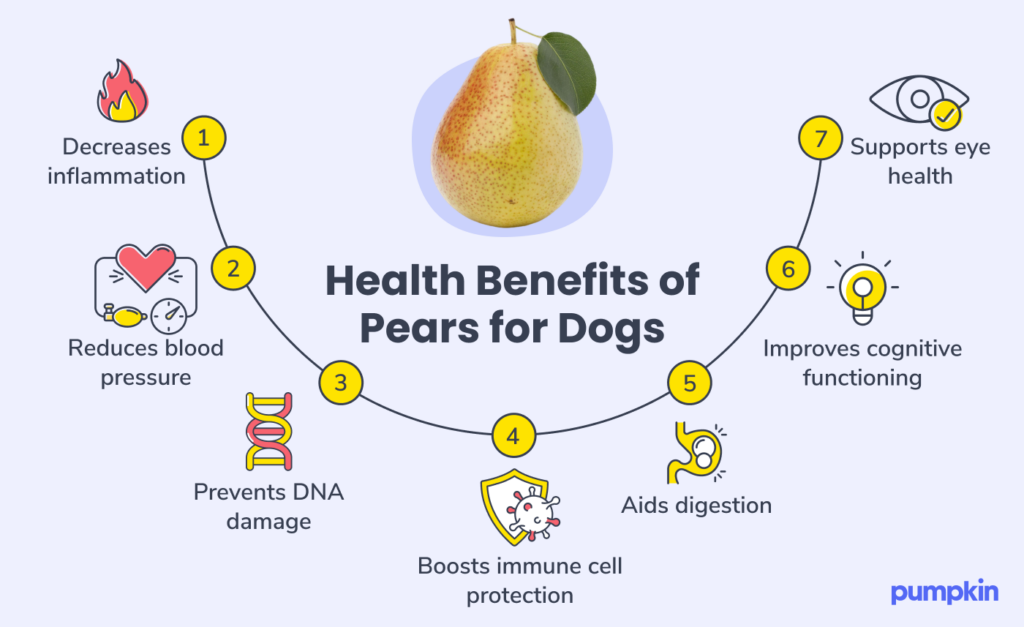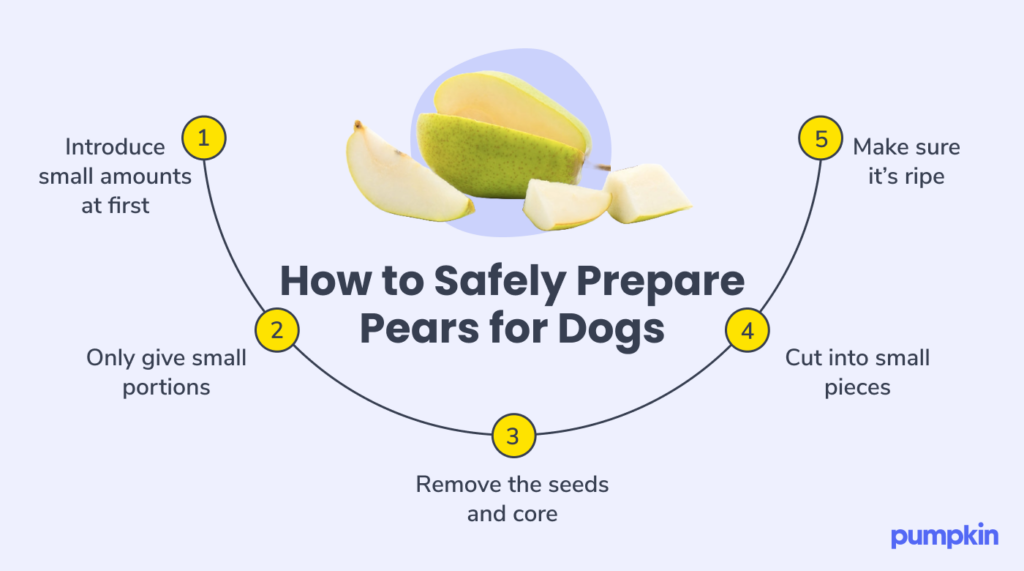Key Points:
- Yes, dogs can eat pears, but the seeds, stem, and core should be removed.
- Make sure they’re ripe or they could be a choking hazard.
- Consuming too many pears can lead to stomach upset in dogs due to high sugar levels.
You’re savoring a juicy pear and wondering if you can share it with your dog? Go ahead.
Pears are not only delicious and refreshing, but they’re also packed with nutrients. That said, they’re high in sugar and their seeds can be mildly toxic. That’s why it’s important to prepare pears correctly.
Let’s explore why pears are good for your dog and how much to share so they’re a safe, healthy treat for your canine companion.
Nutritional value of pears
According to the US Department of Agriculture (USDA), pears are packed with healthy nutrients. A 100-gram serving of pear contains:
- Water (84g)
- Fiber (15.2g)
- Carbohydrates (15.2g)
- Protein (0.36g)
- Fat (0.14g)
- Vitamin C (4.3mg)
- Potassium (116mg)
Vitamin C is a powerful antioxidant that protects cells from damage due to stress, disease, aging, and environmental toxins. Dogs can synthesize vitamin C, so even though it’s not a dietary requirement, it still does the canine body good.
Be aware that a medium-sized pear contains 9.75 grams of sugar, a relatively high amount. Sugar isn’t toxic, but it’s not good for dogs either.
Health benefits of pears for dogs
Just like most fruits, pears have a bunch of health benefits for our pooches. Low in calories, pears are a great snack that won’t pack on the pounds if shared in moderation.

Let’s dive into the health benefits of pears for dogs.
Pears have antioxidants
Feeding dogs antioxidant-rich foods helps prevent DNA damage and boosts their immune system. Pears contain antioxidants that lower inflammation, reduce blood pressure, and improve circulation. Interestingly, the peel of the pear contains up to six times more micronutrients and antioxidants than the flesh of the pear.
Dietary fiber improves gut health
Pears contain both soluble and insoluble fiber. Soluble fiber is prebiotic, feeding the healthy bacteria in the gut, so it’s associated with healthy aging and immunity. Insoluble fiber keeps everything in the digestive tract moving.
Anthocyanins support brain health
Anthocyanins are the pigment in red pears that gives them their striking color. This pigment boosts cognitive function in elderly dogs, supporting better brain health.
Pears aid eyesight
Located in the peel of pears, nutrients called lutein and zeaxanthin support sharp vision.
While lots of studies confirm these benefits for humans, research on dogs is limited. That said, the available studies seem to support the idea that these antioxidants aid healthy vision in dogs too.
Pet Pro Tip: If you have a dog that is prone to ‘snacksidents’ – you should consider getting a dog insurance plan as soon as possible. It can help you afford the best care in the future by covering eligible vet bills for digestive illnesses, toxic ingestion, and more.
Risks to consider when giving your dog pears
Pears are a great snack choice for dogs. But, there are a few small risks to be aware of. First, ensure that treats, including healthy ones such as pears, make up no more than 10% of your dog’s diet to keep them healthy.
Sugar: Too much sugar, natural or not, can upset your dog’s tummy. If your dog has diabetes, it’s especially important to ask your vet before feeding them pears.
Choking hazard: Both mature dogs and puppies can choke on hard pears and big mouthfuls. Make sure pears are ripe and chop them into bite-sized pieces.
Cyanide: Like apples, pear seeds, leaves, and stems all contain traces of cyanide, which can be toxic to dogs. Remove these before feeding your dog a pear.
Fiber overload: Fiber keeps things moving through the digestive system, but too much can cause loose stools and gas.
Canned pears: Canned pears contain too much sugar for dogs. Stick to fresh pears to avoid obesity, upset tummies, and diabetes.
Can puppies eat pears?
Don’t introduce pears too early. Wait until your puppy is a little older, as their digestive system is still developing.
Start with very small portions and cut the fruit into tiny pieces. Gradually increase the amount while monitoring for allergies and other adverse reactions.

Dog-friendly alternatives to pears
If pears aren’t a good fit for your dog, try these other safe and healthy fruit options.
Enjoy feeding your dog pears
Pears are a healthy treat for dogs, but don’t overdo it. When given in moderation, your dog will benefit from the high fiber, vitamin C, and potassium. But be aware that they’re also high in sugar, which can cause stomach issues.
Having a pet insurance plan in place can help keep your pet and your wallet healthy. Learn more about how Pumpkin Pet Insurance plans can help you cover the cost of your dog’s eligible vet bills so they can get the best care without the big cost.
FAQs
- https://fdc.nal.usda.gov/fdc-app.html#/food-details/169118/nutrients
- https://link.springer.com/chapter/10.1007/978-3-031-54192-6_4
- https://www.natsci.upit.ro/media/2478/29nila-stratone.pdf
- https://www.akc.org/expert-advice/nutrition/how-many-treats-can-dog-have/
- https://academic.oup.com/jas/article/doi/10.1093/jas/skae153/7686798
- https://www.mdpi.com/2076-3417/12/23/12130
- https://onlinelibrary.wiley.com/doi/full/10.1111/jpn.13626
- https://pubmed.ncbi.nlm.nih.gov/7839575/




